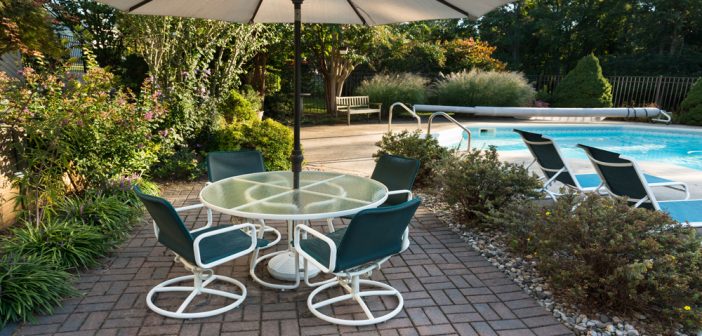The right landscaping can turn your pool and the surrounding area into a relaxing oasis where people will want to gather and spend time together. Want to find out everything you need to know about landscaping for a pool? Follow the helpful guide below.
Think About Your Design and Maintenance Goals
Before you start landscaping, take a step back and think about what you want. Most people desire something that is low maintenance, provides privacy, and keeps debris from falling into the pool. You also might have some unique goals like having an area for poolside barbecues or selecting plants with a sweet fragrance.
Once you have your goals in place, move on to design. Think about what overall theme you want for your pool. Many people go with a lush, tropical theme with overflowing flowers and palm trees or a desert inspired theme with cacti and plenty of rocks. Find something that works with the scale of your pool and the design of your home and other landscaping.
Figure Out Proper Plant Positioning
Think about the overall positioning around your pool. Keep in mind that you will typically want to keep all plants back from the pool, so you do not have to spend a lot of time cleaning slimy leaves away from the pool. Plan your positioning carefully because this will be the hardest thing to change in the future. It is fairly easy to switch out decorative flowers in a bed, but moving the entire bed to a new position is far more difficult.
Common Ways of Containing and Placing Plants Around a Pool
Freestanding: Freestanding plants are typically larger items like trees and shrubs. Carefully decide where you want to place these because they will normally need years to grow.
Beds: Both raised and flat beds are a key part of pool landscaping. They create an area where you can grow visually interesting plants in a way that interact with the shape of your pool and your yard.
Planters: A planter can add some height in an area that is primarily flat and horizontal. These tall, raised containers are ideal bordering the pool or nestled in awkward corners. Even if you have an above ground pool, planters can look quite attractive arranged around the edge. Just make sure the brim is wide enough to keep the plant from shedding in the pool.
Pots: Large flower pots are an excellent way to contain plants around the pool deck and add some greenery to an expanse of concrete or rock. They can easily be moved to make space for entertaining or raised to add more privacy and visual interest.
Ground Coverage: The final type of plant positioning that you will need to consider is ground coverage. This will be used to fill in all the spaces not occupied by your pool deck, plant beds, planters, and other green areas. Grass is a traditional option, but rocks, vines, or other items that require less water are gaining popularity.
Decide on Your Plants
The exact plants you pick will depend on your climate, your budget, and your level of maintenance. In general, you want plants that provide plenty of ground cover, do not shed excessively, do not shed thorns or spines, and do not attract pests.
Types of Plants to Consider When Planning a Pool
Trees: Trees provide plenty of shade, height, and privacy. Palms and citrus are good options while pines and oaks tend to cause problematic shedding.
Shrubs: Shorter shrubs like verbena and euonymus can do well to provide visual interest in planters while taller shrubs like boxwood and viburnums provide a wall of sturdy privacy.
Grass: Look for hardy variants of lawn grass that can stand up to the added moisture and wear around a pool.
Decorative Foliage: There is a huge range of ornamental foliage to consider. Depending on your design, you may want succulents, herbs, ornamental grasses, or more.
Flowers: If you plan to keep the same flowers for years, select sturdy perennials like hydrangeas, peonies, asters, and lilies. To get flowers that you can switch out with the seasons, find lovely annuals like pansies, gladiolus, and begonia.
Vines: Flowering vines like jasmine add both visual interest and privacy, while ivy and other leafier finds provide ground coverage.
Remember Containers, Lights, Rocks, and Other Accessories
When designing your landscaping, remember that you need more than just plants to create a unified design. Select containers and planter materials in attractive shades that coordinate with your design. Consider using metal for a vintage look, weathered wood for a beachy theme, or smooth sandstone for a desert appearance. In pools with a natural landscape, stones, pebbles, and boulders can create lively rock formations that add plenty of texture to the pool. Try to tie in these materials to the concrete or pavers around your pool. Since pools are so frequently used at night, be sure to add lighting. You can choose solar powered lights or select traditional electronic lights. Be sure to place them so they highlight all your landscaping features and show guests through walkways.
Gather Your Tools and Supplies
You will need plenty of soil and mulch to help you with planting the plants in their proper position. Look for something that will add nutrients to the soil and will not blow away. Make sure you have a shovel, rake, shears, hoe, and wheelbarrow for the planting, and grab a blower, some lawn trash bags, and a hose for cleanup.
Prepare and Plant the Area
Once you have all the designing out of the way and have all your tools ready, it is time to begin! Depending on the scale of the project, you might be able to do it yourself over a weekend, or you may need to hire a landscaping crew or get a few friends to help you out. To prepare the area, pull out any weeds and remove any sticks, rocks, and other debris. You can prepare your planters and pots by putting a layer of loose draining material followed by soil. Get your new plants ready by gently taking them out of the pot and massaging the root ball to loosen it slightly.
Once all of your prep work is done, you can begin actually digging holes to place your plants. Dig a hole that is slightly deeper than the plant’s root ball, so you can cover the roots with at least an inch of top soil. Once all of your plants are in place, cover the topsoil with mulch, arrange your potted plants, and enjoy a stylishly landscaped pool deck. If this sounds like too much work, hire a landscaper to transform your pool area and sit back and enjoy your new oasis.









